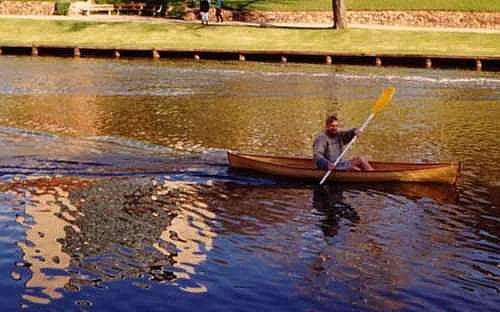UPDATE -The numbers are growing – one took 4.5 hours to build, two other builds took 5.5 hours. Others have taken a week of evenings.
Well, I have been having a big think.

One of the byproducts of the trip to the USA was that I now know that distance canoeing and kayaking is waaaay more fun than I thought.
I sortof imagined it would be tedious compared to sailing.
And it kinda is, but your mind adapts and you are off and going very nicely indeed. The thing I liked was just setting the mind to the task and keeping going, particularly when there are headwinds.
I also liked the independence of camping and the days of having to carry lots of water are over with the gravity filters available these days.
Full Photo set of paddling a canoe on Lake Powell, Utah. Part of the Colorado River.
but back to reality …
Because my income is so little I have pared things to the bone. I find cheap places to rent, have very few belongings and certainly don’t have a car. I remember doing the calcs about 15 years back and finding that a car would cost me an extra $70/week if everything was counted. I doubt it is any cheaper now.
So how do I mix my interest in canoe touring and nice boats with not having a car?
So I started to think in terms of disposable boats. Building really cheap and fast from the cheapest materials available. Either buying them on location at the start or having them shipped there – maybe with bits cut out in advance.
Assembling the boat over a day or so, quick coat of paint, load it up and head off. Up the Murray Darling or any other of the river systems in OZ
At the end the boat just gets given away. It could even work as a group thing.
But how does this influence the design?

We all know that even a little classic canoe like Rushton’s Wee Lassie will outperform and out handle many of the fibreglass production canoes. When the wind and waves come up it goes straight and true, rather than wandering about like a GRP bathtub.
The difference is chalk and cheese. The reason is the hollow in the ends of the wee lassie – which provides a fin at the front and back of the boat. Forget about trying to make a boat track with an inch deep keelson – it is these fins, appropriately placed at the ends of the boat where they have real grip that do the work. A fin at the front and a fin at the back.
You can read more about my Balsa Wee Lassie Canoe here.
The classic shapes are gorgeous. and most quick build canoes are like boxes which handle about as “well” as the mostly poor fibreglass canoes that are available in Australia.
So I wondered … how can the basic simple shape be played with.
I had this idea while talking to Andrew Linn when I was in Oregon looking at lakes and rivers.

So … why not have a fin at the back AND the front to make up the side view of a regular canadian canoe. It won’t be as sweet as the real thing, but it will possibly handle rougher water better than a pure flat bottomed thing.
The other thing that went into the pot – actually the thing that really started the pot were the free boat plans for the “Peace Canoe” that Woodenboat supplied for free to get people started in building boats. I was gobsmacked to see that it came out of 5 sheets of plywood and weighs in at over 100 pounds if built of quality ply.
So introducing the Quick Canoe. Image below.
Not many pieces and the final shapes are worked out already – IT FITS ON THE SHEETS!!! Dimensions are worked out. Am currently working out how to get as much of the boat together in as few sessions as possible. I don’t think it will be quite possible to put the boat together in one day and paddle the next :)
Will it have good directional stability in rough conditions? I do imagine it will be more bouncy in those conditions than a proper canoe but it will have more directionally stable than the normal flat bottomed boat.
This is the first one in undercoat.

Will it paddle well? It does have more wetted surface than the Eureka, but I have squeezed the bottom panel to be quite narrow at the ends. The stability at small angles of heel is about 30% greater than the Eureka. I was tempted to make it a lot skinnier to reduce the wetted area – that might be a worthwhile way to go for a second boat. But the more conservative one is good for a trial.

What will it look like? It will be kinda cute from some angles and I expect it will look strange from others. I did take the sheer curve and widths from the Eureka, so this should look fine.
It is a bit shorter than the Eureka but will come out of three sheets of [B]imperial sized[/B] ply. Maybe around the 60lb (27kg) mark out of a not too heavy species of cheap 6mm (1/4″) ply.
I am working on a smaller solo boat to come out of two sheets. Looks like the length target for that one is a little longer than the Wee Lassie at 11.5ft and probably the weight will be around 45lbs (19kg)
And what do you do at the end of your trip? Just give it away or see if someone will store it for you until the next part of the voyage.
The test boat is built and works fine. Plans are $30.